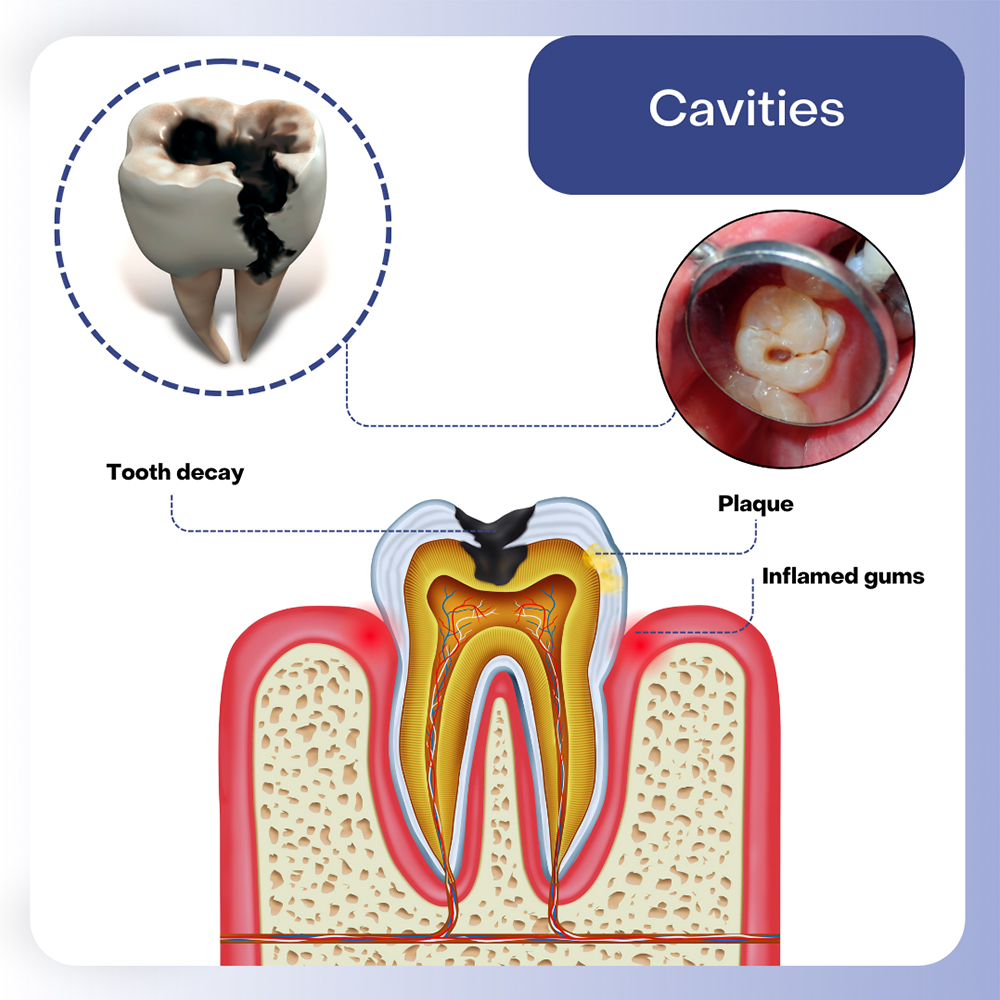Table of contents
Cavities develop when tooth enamel erodes, creating a tiny opening or hole that gradually worsens and becomes larger. If the cavity isn’t treated, it will get progressively deeper and may eventually result in tooth loss.
When a cavity is quite small, it may cause no symptoms, but as the decay worsens, you may notice signs such as:

A cavity doesn’t develop overnight, as it is a gradual process outlined below.
Dental plaque is a sticky biofilm continually forming and coating your teeth. Most is removed when you brush and floss your teeth. Plaque buildup will be greater if you eat a lot of sugary or starchy foods and fail to clean your teeth properly.
Plaque contains bacteria that feed on these sugars, creating acid. The acid erodes your tooth enamel, and repeated exposure eventually causes small lesions or holes in the enamel. These lesions allow the bacteria to enter the tooth, where they can begin eroding dentin, a much softer layer of your tooth that is less resistant to acid. At this point, your tooth may feel more sensitive.
As the cavity deepens, the bacteria eventually reach the dental pulp that contains nerves and blood vessels. The bacteria irritate and inflame the pulp, causing it to swell. As it swells, it creates pressure inside the tooth, causing toothache and dental infection.
Although anyone can develop tooth decay, there are certain risk factors:
Eating sugary foods or foods that stick to your teeth for longer increases the risk of cavities.
Snacking frequently between meals increases the time your teeth are exposed to harmful acids. Snacks that can cause cavities include anything sugary, starchy, or naturally acidic.
Certain teeth are more susceptible to cavities and others, including your molars and premolars. These teeth have lots of grooves and fissures that trap food and bacteria. They are harder to keep clean than front teeth; some people find them hard to reach with an ordinary toothbrush.
Babies sent to bed with a bottle filled with a soothing sugary liquid, milk, or formula are more at risk of developing cavities in their primary or milk teeth. Sending them to bed with a bottle ensures their teeth are bathed in sugars while they sleep, feeding the bacteria that cause cavities.
Failing to clean your teeth thoroughly allows plaque to build up, and it doesn’t take long before it hardens into tartar or calculus. The longer plaque and tartar remain on your teeth, the higher your risk of cavities.
Many people have a dental problem called xerostomia, or dry mouth, where they do not have enough saliva. When you don’t have enough saliva, your risk of tooth decay is higher because saliva helps wash away food and plaque bacteria. It also helps maintain a more neutral pH, neutralizing acids more quickly.
As fillings and dental restorations age, the margins or edges can begin breaking down, creating rough edges that make it easier for plaque and tartar to accumulate. They may start to fit less securely, so decay can start underneath them.
GERD can cause acid from the stomach to flow backward into the mouth, resulting in enamel erosion and, eventually, cavities. If you think you have GERD or acid reflux, see your healthcare provider for treatment.
Once a tooth has a cavity, then it needs professional restoration. However, if you only have a small lesion in a tooth that looks like a white spot, it may be possible to re-harden your tooth enamel. A white spot can indicate a softer area of tooth enamel, and professional fluoride applications may help re-harden it.
Otherwise, you will need restorative dentistry.
The treatment recommended by our dentist will depend on the extent of the decay. Options include:
Fillings are frequently used to restore tooth decay. They can be made from various materials, often tooth-colored composite resin or porcelain. Treatment is quick and cost-effective to complete, and tooth-colored fillings are virtually invisible.
A tooth may need covering entirely when significantly decayed or weakened. Our adult dentist or pediatric dentist will remove the decayed area, carefully reshaping the tooth to ensure the crown will fit nicely. Crowns can be made from various materials, including gold alloy, porcelain fused to metal or PFM crowns, or entirely from ceramics. An all-ceramic crown provides the most cosmetically pleasing result.
If the decay has reached your dental pulp, root canal therapy can be used to save it and restore it. Treatment involves removing the damaged and infected pulp material, cleaning the inside of the tooth thoroughly, and covering the tooth with a ceramic crown to protect it.
If a tooth is significantly decayed, it may be impossible to restore it. We might have to remove it in this case, but this is always the last option. Ideally, if you notice a tooth has become sensitive or has begun to hurt, please come and see us soon.
The more quickly we treat a decayed tooth, the better the outcome. Prompt treatment can prevent the decay from worsening, eliminate any discomfort or pain, and restore your tooth so it looks good and feels comfortable and pain-free.

My name is Victoria Kushensky. I am a general dentist dedicated to remaining at the forefront of my field. Combining compassionate care with extensive knowledge, I offer cosmetic and general dentistry services as well as advanced root canal treatments.
I earned my Doctor of Dental Surgery (DDS) degree from the esteemed New York University College of Dentistry. Throughout my career, I have honed my skills in various dental procedures, ensuring effective treatment for each patient’s unique needs. I prioritize patient comfort and understanding, taking the time to thoroughly explain procedures and address any questions.
More about Dr. KushenskyMy NJ Dentist: Victoria Kushensky, DDS
385 Prospect Ave Suite 304
Hackensack, NJ 07601
(201) 298-8000